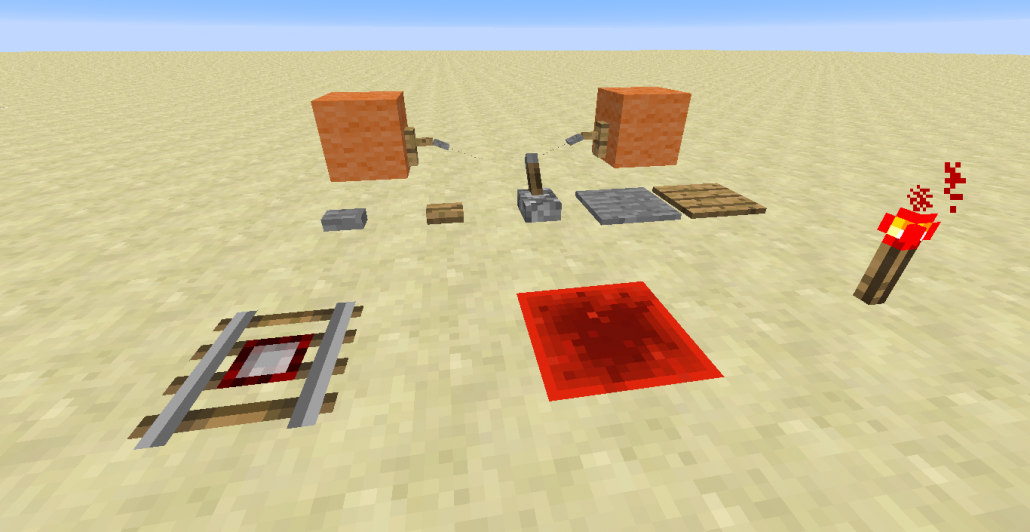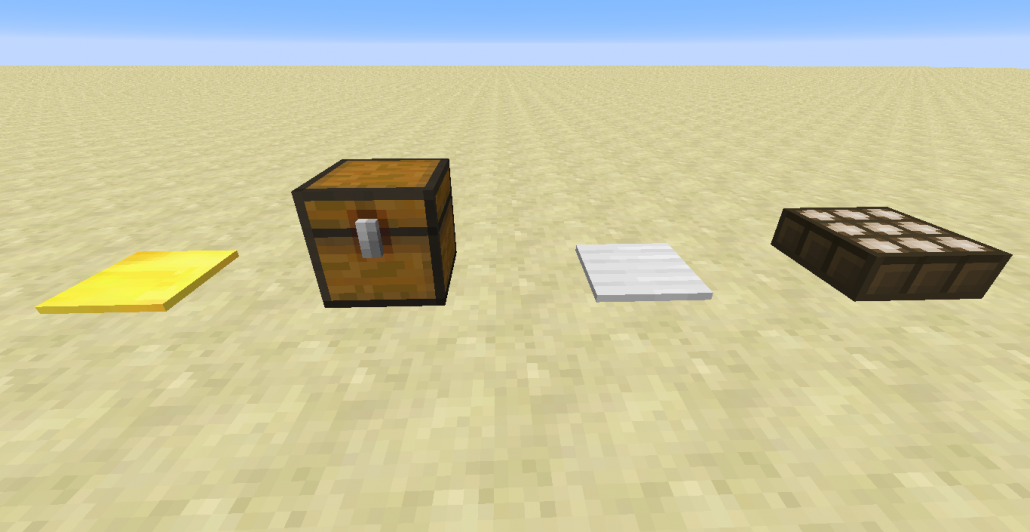Power sources
A power source is anything capable of powering redstone wire. Some can be turned off or on (they are toggle-able), others cannot, but in general there are two main types:
Fixed power sources
Fixed power sources always output the same exact signal strength. They will power any redstone wire adjacent to them with signal strength 15, the maximum possible. They will also strongly power any block they are connected to, with the exception of the redstone torch (see below). We must differentiate two main groups:
- Power sources which are always on. You cannot turn them off in any way and you must destroy them or move them to unpower wires near them. There are just two components in this group:
- Redstone torches are created with a stick and redstone dust. They cannot be moved by pistons. They are the basis of all logic gates in Minecraft and they can be placed on the sides or top of a block, but not on the bottom. If they are placed directly below a block, they will strongly power that block, but if they are placed on it the block will be unaffected.
- Redstone blocks are created by combining 9 redstone dust on a crafting table. Their main advantages are the fact that they act just as a normal block and as thus can be moved by pistons, in addition to being placeable on ceilings.
- Power sources which are off by default. You must activate them by interacting with them in certain ways. Here they are:
- Buttons create a pulse when right-clicked. A pulse is just a signal which stops after a short time. Wooden buttons create a 1.5 second pulse and stone buttons create a 1 second pulse (ignoring lag influence).
- Levers will produce a constant output while turned on. To turn them on, someone must right-click them and the handle will change to the opposite side. The orientation of the lever itself is irrelevant.
- Pressure plates will produce a constant output when any ground-based mob or the player steps on them. Similarly to buttons, the signal remains for longer using a wooden pressure plate over a stone one.
- Tripwire hooks connected with a piece of string will trigger and produce a constant output while an entity falls through or steps on said string. The signal turns off immediately when the entity’s hitbox exists the string’s hitbox. The signal is taken from the blocks to which the tripwire hooks are attached.
- Detector rails produce a short pulse when a minecart passes over them, or constant output if the minecart remains on them. The advantage of this is you can create arbitrarily separated redstone pulses by placing detector rails at arbitrary intervals.
Variable power sources
Variable power sources, as the name indicates, output a signal strength which changes or varies according to their input. Again, we want to consider two types, but this time the distinction is even simpler:
- Non-comparator-based, of which there are only four. These sources do not use a redstone comparator, but are still capable of varying signal strength.
- Trapped chests produce an output proportional to the number of players simultaneously accessing that chest. If two players have it open on their screen, the signal strength is 2.
- Weighted pressure plates produce an output proportional to the number of entities currently on that pressure plate (note even player entities count as just one entity). Note that stacks (such as 64 cobblestone) and the player count as one single entity.
- Gold pressure plates increase the signal strength by 1 every 1 entities. If there are 5 entities on the plate, the signal strength is 5.
- Iron pressure plates increase the signal strength by 1 every 10 entities. If there are 91 entities on the plate, the signal strength is 10.
- Daylight sensors produce an output proportional to the current natural light level. Note this means you cannot over-power a sensor using, say, a glowstone block. Daylight sensors will work when placed even in the deepest caves as long as at least some natural light is getting through to them, even if it’s not coming from directly above them.
- Comparator-based variable power sources make use of a redstone component called the comparator. Comparators enable other blocks in Minecraft to become power sources – specifically, containers. Their output generally depends on how full a container is. Chests, furnaces, dispensers, droppers, hoppers, brewing stands and cauldrons are all considered containers.



